|
Thurs., January 25
11:00 a.m.
Academic Lecture Series -
1 West
Speaker: E. Lunghi, Fermilab
Title: Course 3, Part 2 - Flavor Physics In and Beyond the SM;
CP Violation
2:30 p.m.
Theoretical Physics Seminar -
Curia II
Speaker: P. Fox, Lawrence Berkeley National Laboratory
Title: Reheating Metastable O'Raifeartaigh Models
3:30 p.m.
DIRECTOR'S COFFEE BREAK -
2nd Flr X-Over
THERE WILL BE NO ACCELERATOR PHYSICS AND TECHNOLOGY
SEMINAR TODAY
THERE WILL BE NO ALCPG ILC PHYSICS AND DETECTOR
SEMINAR THIS WEEK
Fri., January 26
3:30 p.m. Director's Coffee Break - 2nd floor crossover
THERE WILL BE NO JOINT EXPERIMENTAL THEORETICAL
PHYSICS SEMINAR THIS WEEK
Click here for NALCAL,
a weekly calendar with links to additional information. |
Thursday, January 25
-Southwestern Chicken Tortilla
-Philly Style Cheese Steak
-Garlic Herb Roasted Pork
-Tomato Basil Chicken Parmesan
-Southwestern Turkey Wrap
-Assorted Slice Pizza
-Marinated Grilled Chicken Cesar Salads
Wilson Hall Cafe Menu |
|
Thursday, January 25
Dinner
Bacon Wrapped Sea Scallops
Ancho Fired Pork Tenderloin
Sweet Potato Stew
Rum Raisin Soufflé
Wednesday, January 31
Lunch
Chili Rellenos
Rice and Beans
Pico de Gallo
Cold Lime Soufflé with Cookies
Chez Leon Menu
Call x4598 to make your reservation. |
|
|
Do you believe in magic?
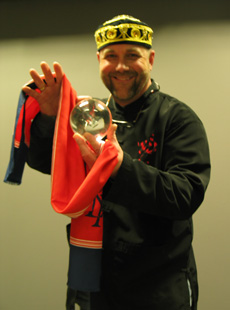
Heavy equipment operator Wayne Braun has been practicing magic for more than 30 years.
Wayne Braun sits in the cafeteria of Wilson Hall, wearing a battered camouflage hat, camouflage pants and a black t-shirt with gold and green jesters on the front pocket. He wraps two rubber bands around each other, and then between his hands, in what he calls a Chinese handcuff. "Watch closely," he says, as he passes one band inexplicably through the other to free himself. Then he breaks one in half. "Whoops," he says. "I'll just put that back together." And after sliding through his deft, calloused fingers, the rubber band is whole again. He smiles widely, adding, "Wow, I'm getting good at this."
It's no surprise that he's good at it. The 56-year-old inventory control employee has been practicing magic for more than 30 years. Growing up in Lombard, IL, his brother and best friend, Dale Braun, was the original magician in their family. But when Dale was killed in a car accident at an early age, Braun picked up where his brother left off. "I'm a living memorial for my brother," he said.
At the age of 33, Braun attended his first magician's conference, where he began to learn how to use his brother's old props. Over the next 11 years, he practiced by offering free magic shows for students at the schools where he sold fundraising products. Finally, he apprenticed for five years with Eugene Burger, one of Chicago's most famous magicians, where he learned more fully the art of deception.
These days, he especially enjoys performing "gospel magic" for Christian groups, in which he sends a message of faith. He's honed down his act to a small suitcase, has lost his original "dorky" tuxedo and red bow tie and takes his illusions to audiences as far away as North Carolina. He spurns the idea, however, that magicians are nothing but trickery. "I'm the most honest man I know," he said. "I'll tell you I'm going to deceive you. And then I do."
--Christine Buckley
|
Now you see it, now you don't

Click the image to see the doe with her tail up--a sign that she has noticed the photographer and is aware of possible danger.
Dear FT:
One of my favorite things about working at Fermilab is the opportunity to see a variety of wildlife throughout my workday. On the afternoon of January 12, I noticed a deer bedded down [lying down] near the road as I drove by the woods West of AP50. I walked into the woods to get a picture, and saw that there were 3 deer there.
Notice how the doe [above] puts her tail up when she is alerted to possible danger.
The other shots are good examples of how well the deer's fur color helps it blend in with its surroundings.
I think it would be fun to have your readers try to spot the second deer in each one.
Christopher Engstrom,
Fire Systems Maintenance
|
grid, Grid or GRID?
In this opinion piece, outgoing iSGTW editor Katie Yurkewicz discusses her favorite question, and why it may matter more than you think.

Even after two years of immersion in the grid world, there's one question that never fails to grab this editor's attention: How to capitalize the word "grid"?
To most in the community, choosing between grid, Grid or GRID probably isn't their most pressing issue. To writers and editors, whose livelihoods revolve around questions of grammar, punctuation and capitalization, it looms large. It's one of the first decisions I faced when starting the original Science Grid This Week in 2005, and I have been called on many times since to defend my choice.
Read More
|
PhysOrg.com,
January 23, 2007:
Physicists Develop Test for 'String Theory'
For decades, scientists have taken issue with "string theory"-a theory of the universe which contends that the fundamental forces and matter of nature can be reduced to tiny one-dimensional filaments called strings-because it does not make predictions that can be tested.
But researchers at the University of California, San Diego, Carnegie Mellon University, and The University of Texas at Austin have now developed an important test for this controversial "theory of everything."
Read More |
|
|
Desperately seeking unification
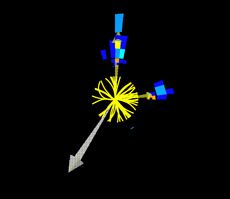
The selected event with the highest missing transverse energy is shown in the figure above. *See below for a more detailed description.
The force of gravity is easily the most familiar of the fundamental forces in physics. Each day, this undeniable force keeps our coffee in our mugs in the morning and ensures that the moon will look down upon us in the evening. Despite its reliable impact in our lives, gravity cannot be described in the language used for interactions amongst quarks and leptons: quantum mechanics. Physicists study gravitation using Einstein's general theory of relativity, which provides extraordinary results for objects as large as planets and stars. However, quantum mechanics and general relativity each break down when we attempt to extend them to describe everything. For more than 35 years, physicists have been seeking a theory that could unify gravity and the fundamental forces of the Standard Model, thus bringing consistency to our descriptions of the universe.
A promising candidate to achieve this unification is a class of models described by the theory of Supersymmetry (SUSY), which introduces a new symmetry between particles responsible for carrying our well-known forces
and the matter particles (also see Result of the Week, November 30, 2006). This model predicts a supersymmetric partner for each known particle of the Standard Model (e.g., quarks and squarks, leptons and sleptons, gluons and gluinos). Because we have not yet observed them, the new particles must be significantly heavier than the existing ones. However, if they are sufficiently light, they could be produced at the energies available at the Tevatron collider. Two of the particles, squarks and gluinos, should decay with an event signature that would make them some of the easier SUSY particles to find.
Physicists at the DZero experiment have been searching for these particles in their ever-growing data sample. Squarks and gluinos should appear as jets of particles recoiling from one or more "invisible" particles which cannot be detected (such particles are also great Dark Matter candidates). The list of candidate events remains consistent with the predictions of the Standard Model without SUSY and allows DZero to set the world's best direct limits on squark and gluino masses. Although this null result does not rule out Supersymmetry, it does leave physicists desperately seeking unification.
*Graphic at top of page: The selected event with the highest missing transverse energy. It has missing transverse energy of 368 GeV and two jets of 282 and 174 GeV. This event has the typical signature expected for squark pair production, but is also consistent with expected signatures of Standard Model backgrounds. Graphic Below: Exclusion domains in the plane of the gluino and squark masses, where the gluino and squarks are the supersymmetric partners of the gluon and of the quarks.
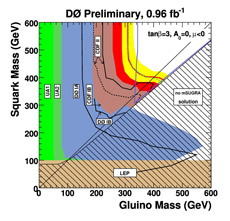
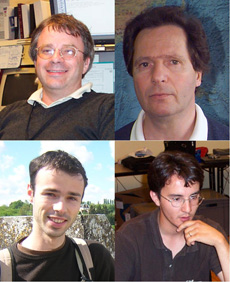
Photo, above: (Clockwise) Laurent Duflot, Jean-Francois Grivaz (LAL-Orsay), Patrice Verdier and Thomas Millet (INP-Lyon) performed the search for squarks and gluinos in the jets and missing transverse energy channel.
Photo, below: (From left) Marc Buehler, Norm Buchanan, Bill Lee, Taka Yasuda, Dmitri Tsybychev, and Markus Wobisch (not pictured) organize the teams who operate the DZero detector 24 hours a day, 365 days a year. The high data collection efficiency they achieve is essential for the success of DZero analyses.
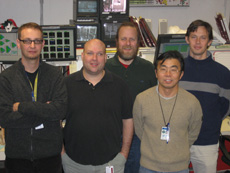
|
|
Metra survey
Metra has extended the deadline for employees and neighbors to participate in a survey about the proposed STAR Line railroad along the east side of Fermilab. Almost 200 Fermilab employees and users have participated so far. Others can still take the survey until Friday, January 26. Please read this article for more information and a link to the survey.
Upcoming Activities
|
|